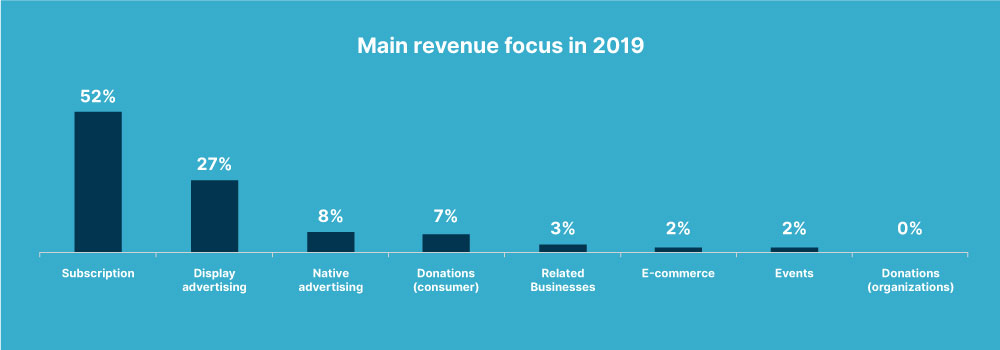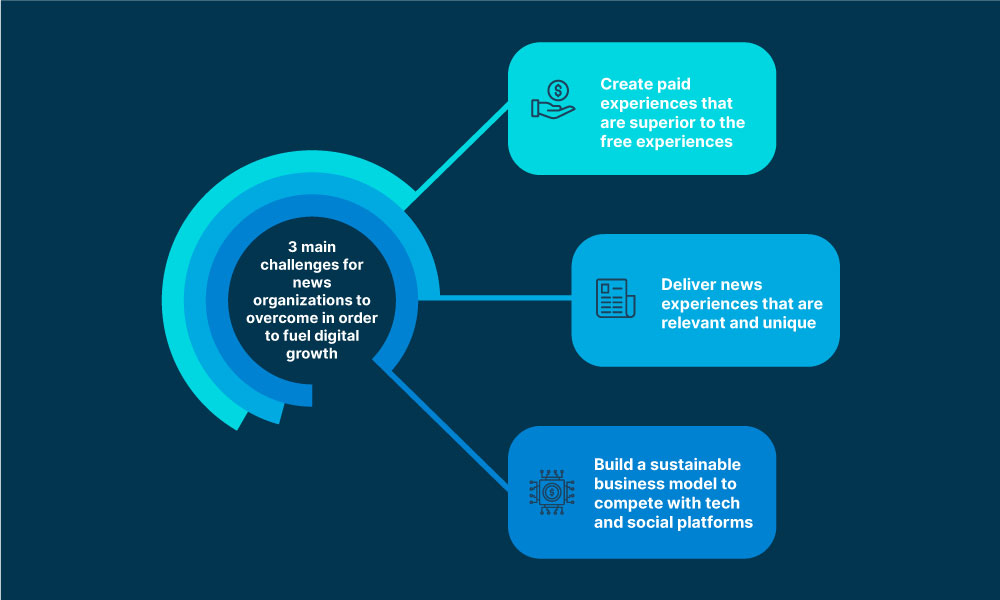The communication industry is facing competitive challenges from social technology platforms and increasing demands from audiences.
As traditional revenue streams for news publishers dry up, we are witnessing a push for more diversified business models across the entire news media sector. How can the media industry balance the necessity of making money while keeping information accessible?
The Decline of Digital Advertising Revenue
Media companies have long struggled to adapt their traditional revenue model into a digital publishing landscape. For decades, online news relied on free content as a strategy. Free content was expected to drive frequency, which in turn drive interactions with digital advertisements. Notable successes of this model are digital native media firms, such as Vox or The Huffington Post in the US or VNExpress in Vietnam. But nowadays, even they face mounting pressure from demanding readers – many of whom are using ad blockers, and competitors alike.
Meanwhile, tech giants like Google, Facebook or Youtube are quickly overtaking digital advertising market shares by leveraging far more efficient audience targeting systems, at both greater scale and lower costs. While digital advertising revenue is still on the rise, very little of that ends up in journalists’ pockets.
In 2018 revenue from ads placed on digital platforms rose by 23% and now makes up nearly half (49%) of all ad revenues, according to eMarketer estimates. Yet 70% of global digital advertising revenue went to just three tech companies: Google (37.2%), Facebook (22.1%) and Amazon (8.8%), totaling at $73 billion between the three. On the other hand, Statista reports an uptick of only 1.8% in global press revenue that year, citing sharp decline in print revenue which hurts the bottom line of many organizations to the point where digital advertising profits alone could not make up for the difference.
Subscription and Membership: The Path Forward
Against this background, it’s no surprise that commercial media companies are looking at more consumer-centric revenue models. According to Reuters Institute for the Study of Journalism’s latest report, subscription and membership is the key priority for the news industry going forward. Over half (52%) of the market leading publishers surveyed expect this to be the main revenue focus in 2019. Compared with just 27% for display advertising, 8% for native advertising and 7% for donations. This marks a huge change of focus for the industry.

| Digital Subscription | a monthly fee that allows readers to bypass a paywall that either restrict all content (eg: The Times), limit the amount of free articles you can read monthly (eg: The New York Times) or restrict access to selected content (eg: The Boston Globe). |
| Membership | a regular fee paid by loyal readers to keep the site free for all. |
According to the study by Felix Simon and Lucas Graves, more than two-thirds of leading newspapers (69%) across the EU and US were operating some kind of online paywall. Reader revenue already made up around 30% of total digital news revenue in 2017 and global digital revenue grew by 28% year-on-year, according to WAN-IFRA’s World Press Trends 2017 report.
One prominent example of a successful paywall is from The New York Times, who initiated their digital transformation and began selling digital subscriptions in 2011. Their “intelligent” paywall, which limits the number of free articles you can read monthly, allows the paper to retain high traffic from light users while receiving circulation revenue from dedicated readers.
They worked hard to create engagement and value for these dedicated readers from day one. Aside from core journalism, the company arranged events and provided unique experiences for subscribers. One example is: the “You ask. Experts answer” column, in which subscribers gain direct access to a panel of experts who are ready to answer their questions in different categories, from lifestyle to nutrition.

Highly focused on the subscription-based business model across all departments, by 2018 New York Times boosted 3.1 million digital subscribers across more than 200 countries, generated $1 billion in consumer revenue and cemented their market leading position.
Customer-Driven Revenue Obstacles
But shifting strategy from a reach + ads model to an engagement + subscriptions model is not so simple. It is forcing publishers to rethink the content they create and the audience that they are targeting. For many publications this will require different skills, new metrics, and an emphasis on higher quality content that justify a price tag.
Moreover, while paid news is a well-proven revenue model in wealthy countries such as the US, UK or Japan, growing subscriptions is not going to be an easy task in markets where there is no culture of payment for digital content like Vietnam. Extensive market research and precise audience segmentation will be required before any local publication attempts to roll out a paywall.
All in all, for markets where paywalls have yet to enter the public consciousness there remains three main challenges for organizations to overcome in order to fuel digital growth.

The paid experience needs to be superior to the free experience
For digital news subscriptions, most of the revenue comes not from the conversion moment but rather in retention of loyal customers. We need to give readers not only a reason to buy, but a reason to stay and not wanting to go back to the free experience. That can only be done by having a distinct difference between the free and the paid experience.
WIRED, the tech magazine, for example invested heavily in three new content streams exclusive to subscribers: longform reporting, ideas essays and issues guides. These in-depth feature articles focus on providing readers with important data and insights for industry insiders that are unobtainable anywhere else. As a result, they’ve experienced an increase in the number of digital subscribers in the first year by nearly 300%.

Nicholas Thompson, editor-in-chief of Wired, said that while there’s always going to be tension between wanting to keep information free and the need for information to be expensive, the most important lesson they learned after one year of putting up the paywall is that subscribers really just want information to be good.
The news experience needs to be relevant and unique
The news feeds need to be relevant to each individual, and also optimized for both our journalistic mission as well as for businesses, ads and user revenue. This simply cannot be done by human labor alone. You need to let technology helps you; algorithms, machine learning, automation.
A notable successful story is The Economist, whose partnership with Lytics – a customer data platform, helped them developed a system that display different offers based on reader’s subscription status and predictive engagement. The system also offers readers featured content based not just on topic interest but also using behavioral scoring, giving readers the type of content in the way they want to read it.
Their commitment to go digital has helped The Economist achieved impressive results in just one year, this includes: decrease cost per acquisition by 80%, triple their digital subscriptions and increase reader’s time onsite with articles powered by data science-based user affinities.
We must find a way to deal with platforms
At the end of the day, the number one thread to news organizations are tech and social media platforms. The winners of the “pay with your data” war are now moving into the user revenue race, both by offering premium subscription services to their own products (I.e Youtube Red) and by offering publishers to get paid for the content on the platforms (i.e Apple in-app Purchase and Facebook’s Instant Article).
Dealing with platforms such as Apple, Facebook, Google, and Amazon, not only in the ads space but also in the user revenue space, becomes utterly important. It is a question of survival of the free and independent press as it limits our ability to have a sustainable business model.
Conclusion
Having users paying for your product is to me the ultimate proof that you have created value. To further fuel digital growth, we need to have a paid experience superior to the free experience, a news experience relevant to each and every individual and we need to find a way to deal with platforms. With fake news, deep fake, filter bubbles, radicalization and polarisation which has devalued journalism, news media is needed more than ever. Our time is now. Embrace technology, love journalism.





